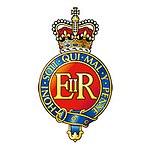Household Cavalry Regiment
| The Household Cavalry Regiment | |
|---|---|
 |
|
| Active | 19 October 1992 – present |
| Country | United Kingdom |
| Branch |
|
| Role | Armoured Cavalry Regiment |
| Part of | Household Cavalry |
| Garrison/HQ | Combermere Barracks, Windsor |
| Motto(s) |
Honi Soit Qui Mal Y Pense (Evil be to Him who Evil Thinks) |
| March |
Life Guards: Quick – Millanollo Slow – Life Guards Slow March Trot past – Keel Row Blues and Royals: Quick – Quick March of the Blues and Royals Slow – Slow March of the Blues and Royals Trot past – Keel Row |
| Equipment | Combat Vehicle Reconnaissance Tracked |
| Commanders | |
| Commanding Officer | Lt Colonel Ed Hayward MBE |
| Colonel-in-Chief | HM The Queen |
| Insignia | |
| Tactical Recognition Flash |  |
The Household Cavalry Regiment (HCR) is an Armoured Cavalry regiment of the British Army based at Combermere Barracks in Windsor. It is the brother regiment of the Household Cavalry Mounted Regiment (HCMR) based at Hyde Park Barracks in London - both regiments together form the Household Cavalry. The Household Cavalry was formed in 1992, under the Options for Change reforms, by the union of The Life Guards and the Blues and Royals in order to preserve the distinct identities of the regiments. A precedent for the Household Cavalry Regiment has previously been set by the Household Cavalry Composite Regiment - active during the Anglo-Egyptian War, the Second Boer War and latterly during both the First and Second World Wars.
The HCR is part of the Household Cavalry, rather than the Royal Armoured Corps (RAC), which encompasses all other armoured and cavalry regiments of the British Army. It serves as the 1st Armoured Infantry Brigade's Formation Reconnaissance regiment and hence is equipped with the Combat Vehicle Reconnaissance (Tracked) family of vehicles, including the Scimitar, and is considered, for operational purposes, as part of the RAC.
The Household Cavalry Regiment was established as part of the Options for Change defence review in 1992.
The House Cavalry Regiment's squadrons served in the Yugoslav Wars on rotations over a nine-year period. Deployments to the Former Republic of Yugoslavia included tours by A and D Squadrons in 1995 and C Squadron in 1999 and 2003. They were largely based at Banja Luka, headquarters of the Multi-National Division (South-West), for which the British Armed Forces were responsible. In 1997 two squadrons from the regiment were awarded the Wilkinson Sword of Peace for their work in "returning the lives of members of the severely damaged community of Banja Luka to conditions approaching normality, in which the seeds of long-standing peace might grow."
...
Wikipedia
